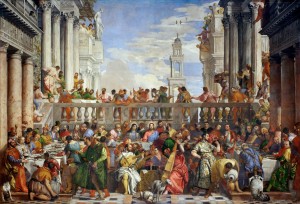Good article about the painstaking fabrication of an exact replica of the painting “Le Nozze Di Cana” by Veronese, which is currently in the Louvre in Paris, having been removed in 1797 from the Fondazione Cini in Venice. The replica now hangs in Venice in it’s rightful location. An extremely advanced, painstakingly complex procedure was followed to scan the painting section by section, and print an exact copy of it onto a specially prepared gesso surface, with a custom-made printer.

The essay focuses on the relationship between the original in Paris and the replica in Venice, and examines the irony that the replica, despite being clearly labelled as such, appears to be the more authentic work, as the artist had painted the original to fit entirely within the context of the Fondazione Cini, in terms of the architecture, lighting and general context. The point is made that when considering the impact of an artwork, we need to consider its context in terms of all the reproductions or copies that have been made of it, and how good they are in terms of quality. The argument is that if an artwork has spawned lots of quality copies, and therefore has great fecundity, the original will be valued even more greatly than if it hadn’t, and this overall picture (what they call the “career” of the artwork) must be considered. The “aura” of the work is brought up, the usual argument being that only the original can truly possess this aura. But we’re asked to consider the example of a Shakespeare play, which may be have been interpreted many times. If there’s a particularly good version, critics may claim it gets closer to the original intent of the work than has been done before, giving us an ever clearer version of the “aura”, and we don’t even think to mention notions of originality or copying. So why one rule for the performing arts and another one for visual art?
They argue the point that on the basis of the amount of effort, expense and resources required to produce a replica of a painting, less is required to produce the replica than the original, justifying the perception of its superiority. Every time a new version of “King Lear” is performed, it takes a similar amount of effort and resources, leaving us with no real sense of a tangible gap between original and subsequent versions. A good point is made about caring for original works of art, that even if no physical reproductions are made, in order to maintain a single work of art it needs to be cleaned, repaired and restored periodically. So even with the original, there appears to be no single, constant state in which it can be said to exist.
These are all good points, but to me, it seems the intent of a reproduction is the important thing. If the intention is to simply ape, or mimic an artwork, then this is inherently less worthy an endeavour than a reinterpretation or reworking would be. It doesn’t matter the amount of effort involved; you could argue that somebody who paints a reproduction by hand will put as much work in as the original artist, maybe more in order to successfully mimic their style. The important factor is that there is no creative agency there, or valid artistic reason to make the copy, unless it’s being explored through another medium or style. That would bring it closer in line with the performing arts examples.
A really good example of an artist whose work speaks to all these topics is Sol LeWitt. He produced a long series of wall drawings during his career which he would distribute to multiple galleries in the form of written sets of instructions, which technicians would then draught on the wall. From one gallery to another, the same piece would of course vary slightly, and the question raised was which one of those is the definitive version, or was the written set of instructions the real artwork?
